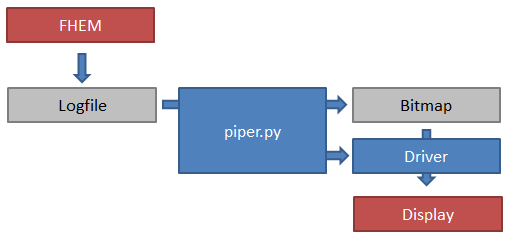Difference between revisions of "Projets:Perso:2013:RaspEink"
(→Software) |
(Added diagram and explanation on how software works) |
||
| Line 15: | Line 15: | ||
* Modified version of the demo driver to send bitmap to display. | * Modified version of the demo driver to send bitmap to display. | ||
| − | [[File: | + | |
| + | Software diagram: | ||
| + | |||
| + | [[File:RaspEink_diagram.jpg]] | ||
| + | |||
| + | The central piece of software is the Python program (piper.py). It processes the logfiles that are created by FHEM and extracts all required information (temperatures, valve positions, humidity and burner status). It then creates a bitmap from this information and launches the driver. The driver, written in C, loads the BMP and sends it to the display through SPI. | ||
| + | Initially, the Python program was supposed to do both the image generation and hardware interfacing but the SPI implementation in Python turned out to be too buggy. | ||
Revision as of 13:51, 1 July 2013
Introduction
The aim of the RaspEink project is to drive a small e-Paper display with a Raspberry Pi. While such a display could serve many purposes (status reports, weather station etc.) it will be used in this project to complete an existing home automation system, namely to display current temperature in all rooms and the status of the heating system.
Hardware
- Raspberry Pi Model B
- 2.7 inch E-Paper display from Embedded Artists
Software
- Raspian linux from official source
- FHEM home automation software
- Perl, required to run FHEM
- Python for extraction of data from logfile and generation of a bitmap
- Modified version of the demo driver to send bitmap to display.
Software diagram:
The central piece of software is the Python program (piper.py). It processes the logfiles that are created by FHEM and extracts all required information (temperatures, valve positions, humidity and burner status). It then creates a bitmap from this information and launches the driver. The driver, written in C, loads the BMP and sends it to the display through SPI. Initially, the Python program was supposed to do both the image generation and hardware interfacing but the SPI implementation in Python turned out to be too buggy.
